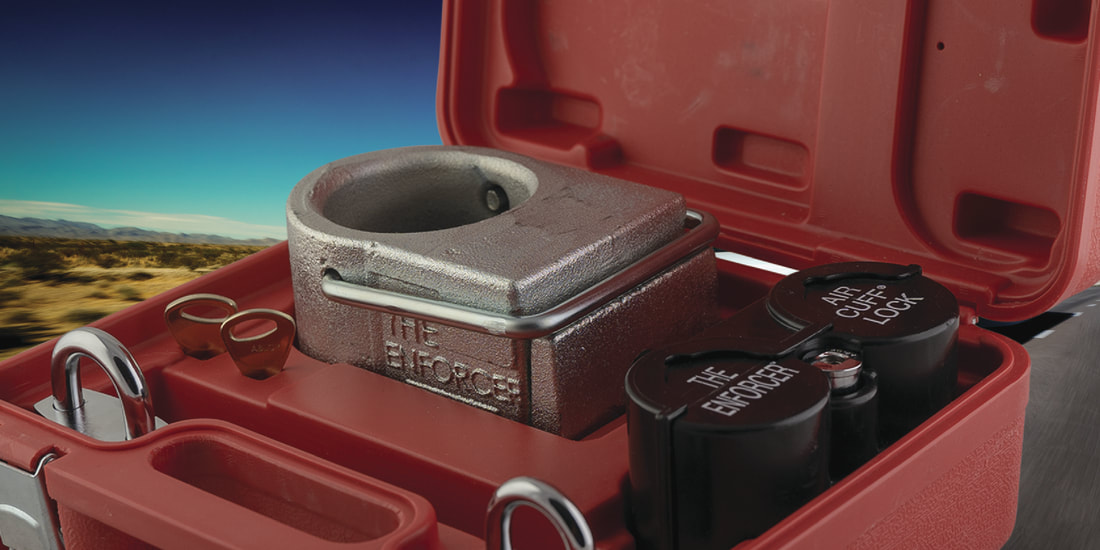|
“My drivers won’t use the lock.” As a lock company, this is a common grievance we hear from security professionals. There are many tractor-trailers on the road and parked at rest areas and truck stops with unsecured cargo doors. Often cargo thieves are looking for a trailer they can break into quickly. If they see a lock installed, they are more likely to move on to the next trailer that isn't locked and can be opened in seconds. How can trucking companies ensure drivers have and use a high quality lock? The following are tactics we’ve seen implemented successfully at fleets in the past. Provide the lock. If it is within your company’s security budget, consider providing locks to your drivers. You can create a lock program that fits your needs. We provide end-to-end security kits that include ABLOY® high security padlocks, king pin locks and Air Cuff ® Locks. Air Cuff ® Locks completely cover and lock the dash mounted air valve levers to prevent the truck and trailer brakes from being released. This lock is an additional layer of security for trucks that are unoccupied, parked or idle. Locks can be keyed different, alike by kit or into a master system for fleet key control. Make it company policy. Security is a priority for many top fleets. Many trucking companies have corporate policies that require drivers to lock their trailers while in transit and when parked. Our Adjustable Lock or hasp and padlock system are heavy duty options. Delivery companies often require that trucks be locked when drivers are making a drop off or pick up. If your fleet includes delivery vehicles, consider the Roll Up Door Lock which automatically locks when the box truck or trailer door is closed. Often times this lock is referred to as a “slam lock”. The slam lock is designed specifically to eliminate driver’s time and effort needed to secure the trailer with a padlock and hasp system. Others trucking companies require verification that a lock is in place before leaving the warehouse or distribution center. Some fleets require their drivers to show proof of purchase of a heavy duty lock while others provide locks for new hires. Whichever channel you decide for your company, be sure your policy is clear and drivers understand what is expected of them. Make sure your policy is enforceable and the consequences of noncompliance are clear. Incentivize lock use. Consider creating a reward program for drivers that incentivizes them to use trailer and truck locks. Use drivers in your fleet to recognize when a lock is being used correctly by another one of your company’s drivers. Have them send a photo of the lock on the trailer to the company as well as the license plate or some other trailer identifier. Ensure drivers only take photos when legal and safe to do so. Get creative with prizes such as sending the driver caught using the lock correctly a gift card as recognition or conducting a monthly raffle for entries. Educate importance of security. Use new driver training to educate on the importance of using a heavy duty lock to secure equipment. Consider providing security devices in the classroom so drivers can learn to use them correctly. Remind drivers of the importance of using a lock anytime there is cargo inside the trailer and when it is empty. Currently, it is difficult to replace stolen equipment due to a shortage of materials and labor. Stolen equipment may mean a driver is out of work for an extended period of time while a replacement is sourced. Awareness of personal repercussions for driver. While drivers may complain about the inconvenience of having to lock their truck and trailers, the inconvenience of a theft is much greater. There can be financial losses to the drivers themselves as a result of a theft. There is the lost revenue from the current load and future loads. They also risk harming their reputation. Drivers are often interviewed by police after a theft. The police are tasked with gathering evidence to decide if the driver was part of the theft or not. The last step in securing your fleet’s trucks and trailers is often dependent on your drivers taking the time to secure the locks. Encourage or require use of a high security locking device using the tactics outlined above. Drivers and companies ultimately benefit when security is prioritized.
0 Comments
|
Categories
All
Archives
February 2024
|
©2024 Transport Security, Inc. 820 South Pine Street Waconia, MN 55387 952-442-5625 enforcer@transportsecurity.com


 RSS Feed
RSS Feed